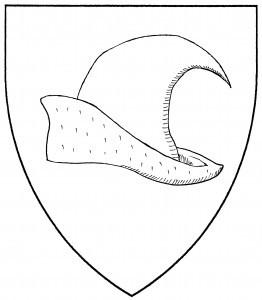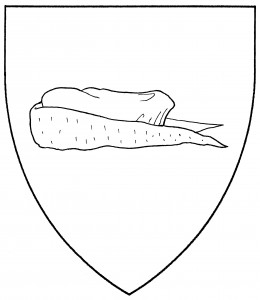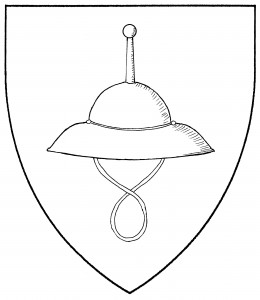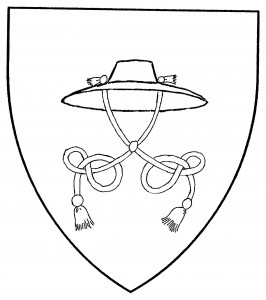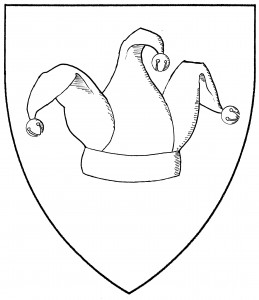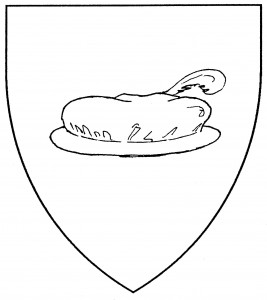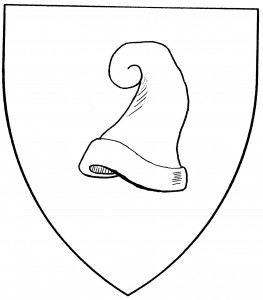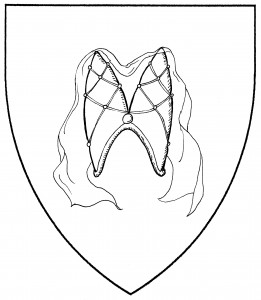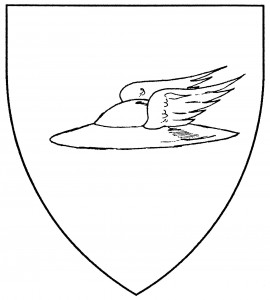A hat is an article of clothing which covers the head. There are a wide variety of hats used in heraldry; no type of hat is the default, and there exists no standard “generic” hat. The exact type of hat thus needs to be blazoned; this was frequently done by a simple description, e.g., “a conical hat”, as in the arms of von Bornstedt, 1605 [Siebmacher 177]. One form quite common in Continental heraldry is blazoned in modern French as un bonnet albanais, an “Albanian cap”, although we can find no connection between it and Albania.
One specific type of hat found in period armory was the “cap of maintenance” or “cap of dignity”. It was used in Scots crests to signify baronial status; but it was used in English crests after 1350 by non-peers [Hope2 155]. It was also used as a charge in its own right, as in the incredibly ugly civic arms of Gloucester, 1536 [Hope2 335, Parker 333]. In the Society, the cap of maintenance gules, trimmed either ermine or argent goutty de sang, is reserved to members of the Order of the Pelican.
Another hat in period armory was the judenhut or “Jew’s hat”; this form of hat was mandatory garb for Jews starting in the 11th Century, but soon became a mark of honor among them. It’s found in the canting arms of Judden, c.1370 [Gelre 94], and was used in the armory of both Jews and Gentiles [Edward Kandel, “The Origin of Some Charges:, Coat of Arms vol.1 (N.S.) No.95, Autumn 1975, p.208]. It is accepted for use in the Society.
Of religious headgear, the “mitre” was used as a charge almost exclusively in arms and crests of bishops and bishoprics; the few secular examples, such as the arms of Kirchberg, mid-16th C. [NW 175], are not sufficient to dispel this appearance of presumption. The mitre has been disallowed, pending further examples of its secular use. The “cardinal’s hat” or “protonotary hat”, on the other hand, is commonly found in secular armory with no religious implications, such as the arms of von Dobeneck, 1605 [Siebmacher 151].
Of hats unique to Society armory, a popular type is the “fool’s cap” or “jester’s cap”: a forked hat of two or three points, with bells at the points. This sits on the head, as opposed to the (more period) jester’s hood, which completely covers the head. There is also the “flat cap”: a brimmed beret, which may be jewelled or befeathered, as exemplified in the drawings of Holbein, 16th C.
The “Phrygian cap” is a floppy, conical hat found in Greek art. The “hennin” is a woman’s head covering, from the 15th C., with either a single conical point or a double-horned form; the type must be specified. Though the hennin was usually worn with a veil, in Society armory it may be drawn with or without a veil, at the artist’s discretion; the illustration shows a double-horned hennin. The “arming cap” is a close-fit skullcap, worn inside a helm as insulation.
Finally, the “petasus” or “cap of Mercury” is a flat wide hat with wings; it was one of the accoutrements of the Greek god. For related charges, see head (human’s), helm, hood.
Alice Jean Huewy bears: Azure, on a bend sinister argent three Albanian caps reversed palewise azure.
Casamira Jawjalny bears: Azure, a jester’s hat lozengy gules and Or and a chief Or.
Edmund Renfield Wanderscribe bears: Per bend potenty gules and argent, a sun in his splendour Or and a cap of Mercury azure, winged argent.
Lucrezia di Bartolomeo bears as a badge: Purpure, on a heart Or a double-horned hennin gules, trimmed argent, a bordure Or.
Joshua ibn-Eleazar ha-Shalib bears: Azure, in saltire a ladle inverted and a recorder between four Jewish hats Or.
Christopher Thomas bears: Argent, a flat cap purpure plumed and on a chief azure three Pierrot masks argent.
Valentine Christian Warner bears: Vert, three long conical caps Or turned up ermine.
Declan of Drogheda bears: Argent, a Phrygian cap purpure.
Brendan Kanobe bears: Argent, a sugar-loaf hat gules and a bordure sable.
Dirk of Drei Eichen bears: Or, a cardinal’s hat gules and on a chief sable, three fleurs-de-lys Or.
Sveinn Harðfari bears: Per bend Or and bendy gules and Or, a demon’s head couped affronty gules wearing an arming cap sable.
